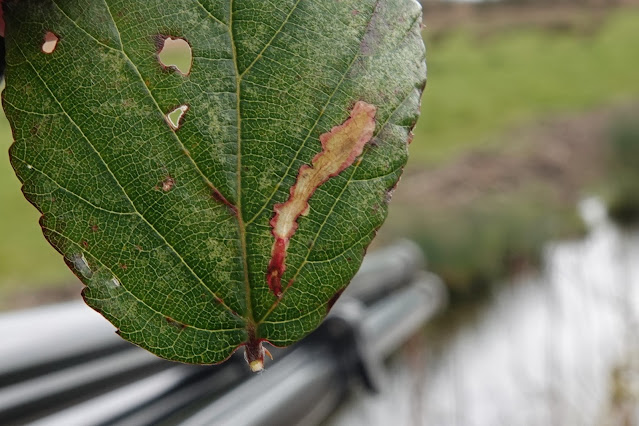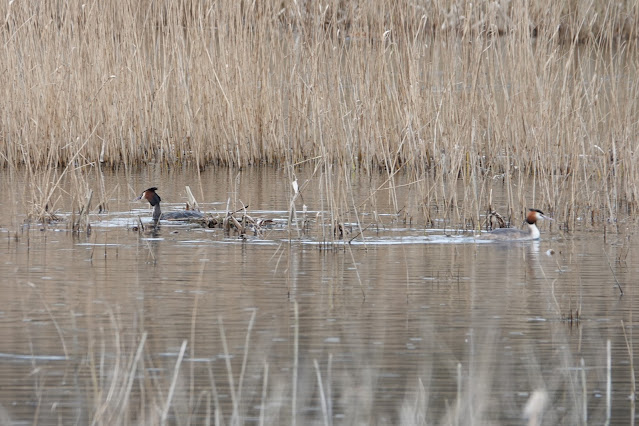After a final fine breakfast at Speech House we packed up and made our way south to Steart WWT reserve on the Bristol Channel passing the Mandarins on Cannop Pond for the day list and a couple of Roe Deer along side the M5 on the way.
At Steart we had not even left the car park when a Tree
Sparrow got up out of the vegetation by the road and flew around calling
stridently. It landed out of view behind
the works compound with the House Sparrows but we could not then re-find
it. Not quite what I was expecting.
Cetti’s Warblers were in good song and Reed Buntings and
Skylarks were giving it a good go despite the gloomy conditions. I showed the group the two common moth leaf
mines on Bramble and inside the first Teasel I looked at was the grub of Endothenia
gentianaeana (the one without the anal comb if you must know).
 |
| Stigemlla aurella |
 |
| Coptotriche marginea |
 |
| Endothenia gentianaeana |
Avocets could be heard squabbling on the main lagoon along
with grumbling Shelduck even before got there and soon the whole flock along
with a mass of Wigeon, Shoveler and Teal were in the air as a Marsh Harrier
and then a tatty Red Kite drifted through.
 |
| Red Kite |
Two more Harriers were seen along with a couple of Buzzard
as well as singles of Redshank, Dunlin and Lapwing and four Oystercatcher. Wader numbers and variety were disappointing
but three sieving immature Spoonbills were soon found and it was good to see
them all in action.
 |
| Spoonbills |
A distant Goose resolved itself into a Bar-headed and Raven
and Rooks were noted while the flooded weedy field alongside failed to yield
any Water Pipits although there was a flock of Linnets and some Pied Wagtails
and Reed Buntings and a male Pheasant sought sanctuary up the top of Hawthorn
while a Fox patrolled beneath and a Buzzard looked on.
A Chiffchaff was half heartedly singing in the bushes but
remained hidden and as we approached the next hide the first of several Water
Pipits got up and flew over calling and try as we might we could not find one
on the deck. We settled in to overlook the tidal marsh and within just a few
minutes a full adult male Hen Harrier was picked up quartering the distant margins. He
gleamed silver and white in the low light and we followed him for several
minutes until he dipped behind the hedge and out of sight. Carol then picked up a Short-eared Owl the
had a quick fly round before dropping back down never to reappear!
Two Ravens stopped on the closest pylon – the male being
noticeably bigger than his partner and with a few spots in the air was strolled
back for lunch seeing a fine clump of Marsh Marigold and finding several Cigar
Galls in the Phragmites.
 |
| Cigar Galls of the fly Lipara lucens |
 |
| Ravens |
 |
| Limnaecia phragmitella on Lesser Reedmace |
 |
| Marsh Marigold |
Lunch à la car-park and then down the road to have a look at the inevitably expansive tidal flats of the Bristol Channel with Dunlin, Curlew, Redshank and odd stalking Grey Plover but the birds were far away and the light grim.
 |
| Lunch with the Goldfinches |
A pair of Stonechats posed nicely for the crew and Cetti’s Warbler shouted but remained invisible
while Reed Buntings flicked white tail sides.
Skylarks were squabbling over the intertidal saltmarsh area and a flock
of Meadow Pipits moved over the road and sat swaying on the barb wire fence.
 |
| Stonechat |
 |
| Wild Radish |
We cut our losses and headed back inland to the Somerset Levels and parked up at Ham Wall before walking down to Shapwick, as far as Noah Lake. A stridently calling Firecrest was a great start although it went silent as soon as we got close enough to actually look for it which was frustrating but we found some glowing Scarlet Elf Cups in the process which was cool.
Great White Egrets became our constant companions on the walk down and
back with perhaps a dozen being seen. Almost all that were seen well were
sporting the black bills of breeding plumage and it always surprises me just
how this makes the bill actually look smaller and slimmer than the orange winter
version. Several nesting platforms could
be seen and the pranced around and
postured with necks out in exaggerated flight.
I love the fact that they are now an integral part of the birding day.
 |
| Great White Egret |
Three different Bitterns were heard booming although none
were especially close while numerous Water Rails squealed and kipped and noisy
Kingfishers played chase just out of sight through the wet woodland although we
did eventually get a couple of brief fly by views.
Redwings and Jays were in the woods and from the hide there was once again huge raft of Wigeon and Pintail. The latter were looking especially fine and the males had all acquired a rich apricot flush to their breast. There were only a few Tufted Ducks and once again Ring-necked Ducks proved elusive for me. Perhaps we shall visit Decoy Lake tomorrow.
A female Marsh Harrier was pushing the duck
around and with time pushing on we too felt the need to start walking
back. There were Pochard and Great
Crested Grebes with the Wigeon and Gadwall on the main pool but still no
Bitterns emerged to finish off the visit and it was left to a super glowy pink
male Bullfinch in the flowering Blackthorn to welcome us back to the van.
 |
| Great Crested Grebes |
 |
| Greater Reedmace |
It was time to head to The Swan in Wells and we went via the
undulating Westhay Moor road. The fields
had dried out somewhat from January and there were about 30 Little and seven
Great White Egrets in the fields but we could not find one Cattle Egret where 450
had been present two months ago! Let’s see what tomorrow holds.
 |
| The Bishop's Palace |




No comments:
Post a Comment